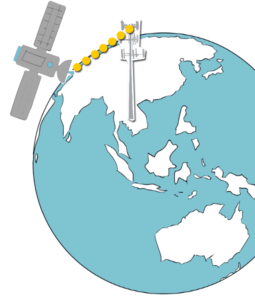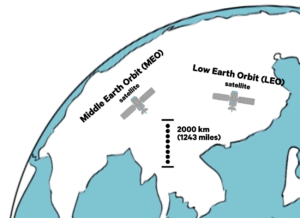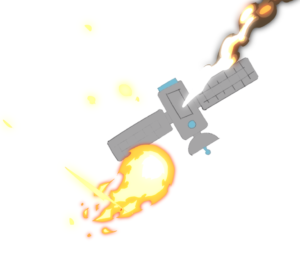Sometimes, the nature of the terrain, the remoteness of the location or the sheer expanse of the area is too much even for the solid coverage of radio networks. In such cases, satellite communications can be an option, but with the myriad of satellite technologies out there, it can be hard to know where to start. In this lesson of the Tait Radio Academy, we take a closer look at the pros and cons of satellite.
The below text is a summary of the Tait Radio Academy lesson. For the full course with detailed information on satellite frequencies and technologies such as BGAN and VSAT, click here
 Satellites communicate like this: a communications satellite, parked in an orbit above the Earth, receives radio signals transmitted from a ground station which has a parabolic dish antenna aimed at it. The satellite amplifies the signals and re-transmits them to be received by appropriately aimed dishes located at multiple ground stations back on Earth.
Satellites communicate like this: a communications satellite, parked in an orbit above the Earth, receives radio signals transmitted from a ground station which has a parabolic dish antenna aimed at it. The satellite amplifies the signals and re-transmits them to be received by appropriately aimed dishes located at multiple ground stations back on Earth.
A comms satellite can create a vital communications link between widely spaced locations on Earth, thus providing high-bandwidth channels to carry voice, data, video or internet.
Different types of satellites
The satellites themselves can be parked in various types of orbits above the Earth. In a geosynchronous (GEO) orbit the satellite follows a high-altitude path (35,786 km (22,236 miles)) with a speed matching the earth’s rate of rotation. This allows the satellite to appear to be fixed over the same location on Earth.
A geostationary orbit is a special case of this type, where the path is directly above the Earth’s equator. Comms satellites are commonly placed in geostationary orbits since the satellite dishes on the ground can simply point to the same fixed position in the sky and don’t need constant re-alignment to track the satellite. GEO satellites provide unrivalled comms coverage, requiring only 3 or 4 to cover most of the Earth.
 Closer to Earth, there are Middle Earth Orbit (MEO) satellites – circling at between 2,000 km (1,243 miles) and GEO altitudes – and Low Earth Orbit (LEO) satellites at still lower altitudes.
Closer to Earth, there are Middle Earth Orbit (MEO) satellites – circling at between 2,000 km (1,243 miles) and GEO altitudes – and Low Earth Orbit (LEO) satellites at still lower altitudes.
These need constant automatic tracking by earthbound dishes or require users to wait for the next available satellite to pass overhead.
Reliable, but high latency and single point of failure
Bouncing a signal up to a satellite and down again takes time – up to half a second for a round trip for a GEO satellite and slightly less for MEO or LEO satellites closer to Earth. This high network latency, which affects all satellite communications, can rule out some applications, such as remote real-time control of machinery.
 Although satellite networks are themselves extremely reliable (often quoting 99.7% availability), a satellite nevertheless represents a single point of failure, vulnerable to damage from orbiting debris or solar flares which can be difficult to repair.
Although satellite networks are themselves extremely reliable (often quoting 99.7% availability), a satellite nevertheless represents a single point of failure, vulnerable to damage from orbiting debris or solar flares which can be difficult to repair.
Best of both worlds: unifying your critical communications
By combining satellite with other network bearers such as WiFi, cellular, LMR, or IP over ethernet, a variety of fully-functioned communication systems can be designed for remote locations without sacrificing connection to the rest of a critical communications system.
The big issue with using satellite for comms is cost, since you are paying either by a flat rate or by the minute or by the megabyte. There are options for controlling cost, with companies offering different charging models, but to get the best of them it is necessary to have a clear idea of where satellite comms should be deployed as opposed to terrestrial alternatives.
Nevertheless, adding satellite as a bearer to a multi-technology solution, brings a whole new level of additional coverage, accessibility and communications flexibility.
Tait Radio Academy
Want to know more? For the full lesson, head over to the How to Choose the Right Communication Bearers course on the Tait Radio Academy, where you can learn about the pros and cons of not only Satellite, but also LMR, WiFi, Satellite, and LTE.
The Tait Radio Academy is a free training resource, providing foundational education on a wide range of critical communications topics. From basic radio awareness to Industrial Control Systems, there is a range of material for people in both technical and non-technical roles.
Register to Tait Radio Academy unlock access to quizzes, downloadable study guides, the ability to join our Discussion Group on LinkedIn, and more.






Hi Tait Radio Academy Team! Your knowledge about satellite communications is extensive and in-depth. I have learned much from the above guide about the pros and cons of satellite communications. Furthermore, if you would like to learn more information about satellite networks & communications and digital data connectivity, you can check out IEC telecom blogs. You will definitely learn a lot.